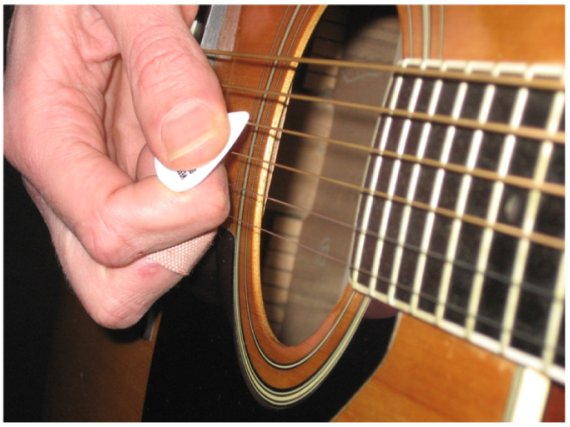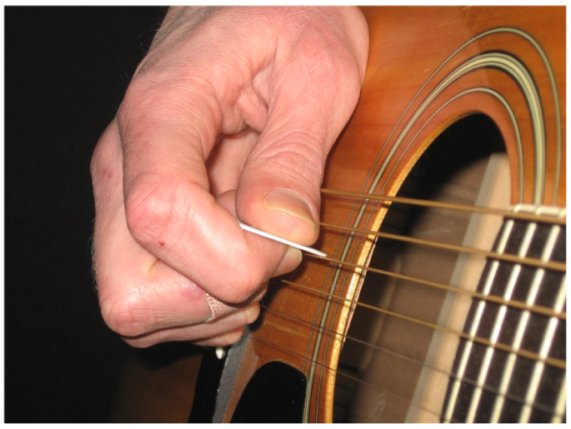
Most guitarists are very comfortable strumming chords using a downstroke strum motion. To keep things simple, this is usually the first strum motion guitar players learn. Adding upstroke strums to play new strum patterns is the next step for guitar strumming lessons and most guitarists struggle with getting a smooth, even sounding upstroke.
To eliminate the pick feeling like it is getting “stuck” on the upstroke and improve your strumming technique, I am going to show you two key guitar strum techniques for your strumming hand. First, let’s look at what causes the upstroke strumming problems for most guitarists.
Guitar Upstroke Strumming Problem #1: The downstrum pick angle
After playing downstroke strums for awhile, most guitarists start to angle their pick toward the floor. This angle looks like this:

This angle gives the guitarist a very smooth feeling as the pick moves over the strings on the downstroke and also creates a very good sounding guitar tone. However, the problem arises when the guitarist attempts to play the upstroke strum using the same pick angle. Because of the pick angle, the pick “digs” into the strings on the upstroke, ruining the smooth and even strum feel and also creating a harsh guitar tone that does not mesh with the good sounding downstrum tone.
Now that you are aware that this is happening, we can correct the problem by simply adjusting the pick angle to create a pick position that will work for both upward and downward guitar strumming. We want to create a pick angle that does not lean so much in one direction that it makes it difficult to get a good strum motion in both directions.
Simply rotate your pick hand wrist back just a bit to create a pick angle that it more perpendicular in relation to the strings. It should look more like this:

Now the pick will now glide more evenly over the strings in both the upward and downward strumming motion. A small adjustment of the pick angle and just being aware of what is causing the pick problem will go a long way toward improving your feel and the tone of the guitar on the upward strum and make your guitar strum techniques much easier to play.
The second part of our guitar strumming lessons will help you add the finishing touch to your corrected pick angle.
Guitar Upstroke Strumming Problem #2: Getting the “brush” feel as the pick strums the strings
Now that we have corrected the pick angle problem, let’s look at our pick grip pressure and how this affects our ability to strum in both up and down directions.
When strumming chords, it is important not to over grip the pick and hold it too tightly with the pick hand. For strumming chords, just tight enough to keep the pick in the hand without losing your grip or control of the pick is the correct amount of pick grip pressure. Other techniques may require a different grip pressure, but in our guitar strumming lessons and strumming chords we want to use the least amount of pressure necessary.
If you maintain a relaxed grip on the pick when strumming, the pick will angle slightly toward the floor on the downstroke and toward the ceiling on the upstroke. This slight change in the pick angle will start to happen almost automatically as you practice these guitar strum techniques.
It looks like this on the downstroke:

And this on the upstroke:

With the proper amount of pick grip pressure, this is not something that you will need to make happen consciously—it will happen automatically. The feel of the pick strumming the strings will actually feel like the pick is “brushing” over the strings. It will not feel like it is getting “caught” or stuck in the strings. The best guitar strum techniques are often made up of very small hand position adjustments and by becoming aware of what is happening with your pick angle and grip pressure.
These guitar strumming lessons will help you get that relaxed strumming feel and a great strumming sound from your guitar. Remember to keep your pick angled in a way so that it is not tilted toward the floor and to maintain a relaxed grip pressure to keep your strumming smooth and sounding good.
You can learn to the play the guitar. If you have been wondering if you have what it takes to become a great guitar player, I’m here to tell you that your desire to learn the guitar combined with the right instruction is a winning combination. Learn how to play guitar now with these beginner guitar lessons.